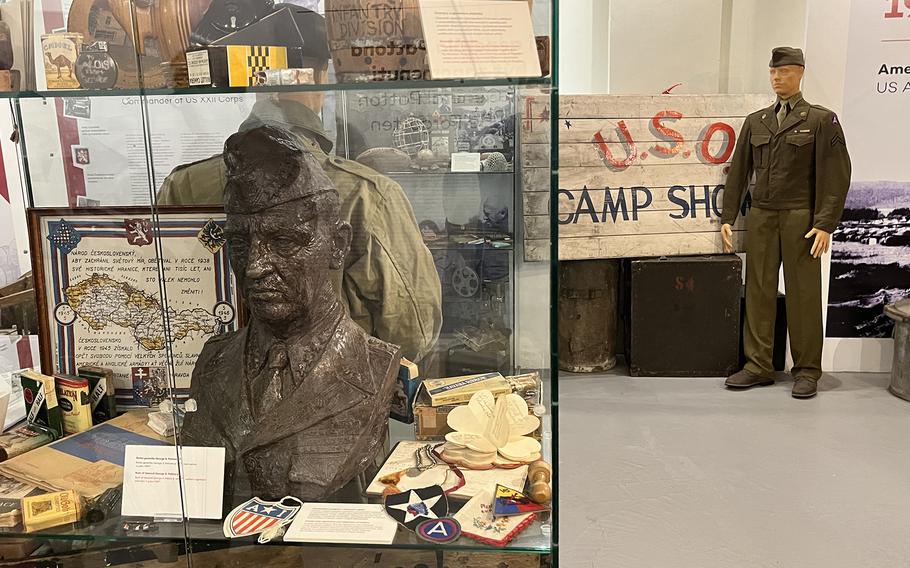
Patton Memorial Pilsen in the Czech Republic, dedicated to Gen. George S. Patton, Jr. and the city’s liberation in 1945, features more than 800 pieces of memorabilia, including personal items belonging to the famed military commander. (Matthew M. Burke/Stars and Stripes)
Gen. George S. Patton, Jr. was a hard-charging leader that continues to inspire students of military tactics and history.
The West Point graduate distinguished himself as a tank commander in World War I and later during the World War II campaigns of North Africa, Sicily and continental Europe.
He survived the war but died at 60 on December 21, 1945, 12 days after a car crash in Mannheim, Germany.
The Patton Memorial Pilsen in the Czech Republic is one of two museums in Europe to bear the Patton name and stands as a testament to the city’s liberation from the Nazis, curator Ivan Rollinger said.
It features more than 800 items dating back to Europe’s liberation, from GI uniforms, tools, first aid supplies and food rations to beach obstacles and pieces of felled aircraft. It also contains some of Patton’s personal items that were donated by his descendants.
“Patton was the best general of the United States during World War II,” Rollinger said. “This is a symbol of freedom.”
Patton was born in 1885 to a military family in San Gabriel, Calif., according to the Library of Congress. He attended the Virginia Military Institute, followed by the U.S. Military Academy at West Point.
In 1918, he led the first U.S. tank units into World War I in France. After the start of World War II, he commanded the Western Task Force in North Africa, the Seventh Army during the invasion of Sicily and the Third Army in their push across France, Germany and Czechoslovakia.
Known as a maverick who led from the front, he captivated the American public by pushing his troops hard, rolling over enemies and vast swaths of territory, with a sharp tongue and ivory-handled revolvers.
Pilsen, located approximately 40 miles from the German border in western Bohemia, was liberated by Patton’s 16th Armored Division on May 6, 1945, after six years of brutal Nazi subjugation.
Rollinger began collecting military paraphernalia after the fall of communism in 1989, he said. He and like-minded friends opened the museum to show off their collections in 2005, with cooperation from the city.
The collection swelled as American and Belgian veterans and their families flocked to the city’s annual Liberation Festival each May and donated items. The assortment includes one of Patton’s signed garrison caps.
The museum takes guests on an informative journey, year-by-year, from the beaches of Normandy to the Battle of the Bulge and western Bohemia. It also details life in Pilsen during the war and after its liberation.
A wall display signed by all the veterans that visited over the years, including Patton’s grandson, has taken on new meaning as the war generation has largely passed on.
The museum is clean and provides well-displayed memorabilia and descriptions. It’s great for students and history enthusiasts.
Rollinger plans to move the museum following $9 million restoration of the city’s former Nazi headquarters on Klatovská Street in 2026. The building was the site of German Lt. Gen. Georg von Majewski’s surrender and subsequent suicide.
Pilsen is a lovely European city with a lot going on. There are entertaining soccer matches, the Pilsner Urquell brewery, good restaurants and some impressive architecture. The Patton Memorial should be high on the must-do list as well.
As the years tick by, memories of the Greatest Generation fade, but clearly, Pilsen remembers.
On the QT
Location: KD Peklo, Pobrezni 10, Pilsen
Hours: Open Wednesday through Sunday, 9 a.m. to 4 p.m.
Cost: 100 Czech crowns ($4.50) for adults, 70 crowns for children and 200 crowns for a family of four.
Information: Online: patton-memorial.cz/en